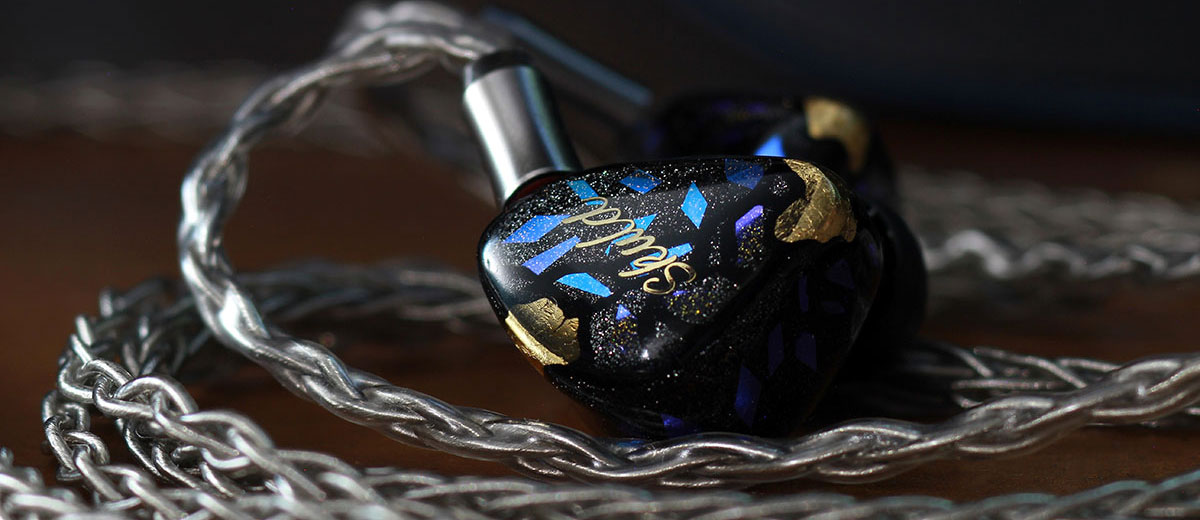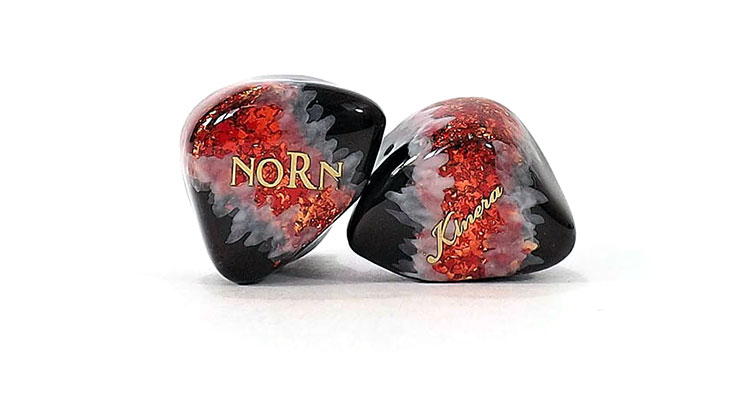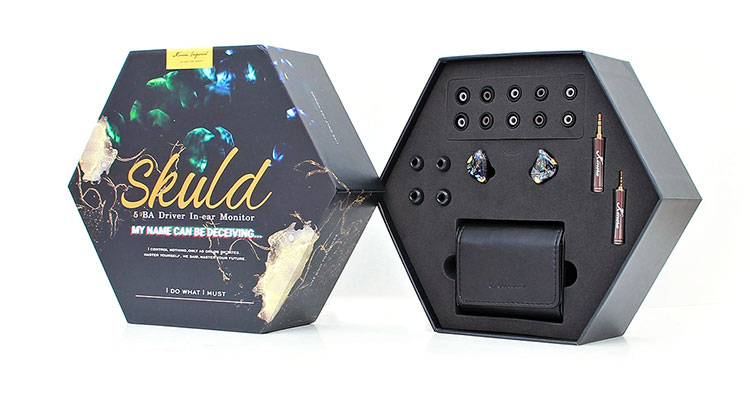Sound Impressions
Summary
It seems the Kinera Imperial Skuld is very flat from the bottom octaves all the way up to past 8 kHz and I found that to surpass Kinera’s own claims. There is a mid-centric tuning although the lower and top octaves are present but just in a more polite presence.
The 2×2 full range BA driver assemblies seem to do a good job at producing midrange detail that is well defined and tonally pleasant, crisp, and spacious. There seems to be a high amount of some micro detail other budget IEMs fail to produce.
The bass seems to have a familiar BA bass character of being present but lacks in punch and slam. However, the bass response is very flat, fast, well-controlled with every note coming through evenly and every note somehow is produced at the same output level giving the bass lots of definition and good individual note distinction.
The high frequencies somewhat follow the same tuning characteristic as the soft-mannered bass. The treble response is also soft-mannered but drops in output level just a hair while still remaining sharp and crisp enough to be enjoyable while at the same time remaining absent of edginess, sibilance, or harshness because of the modest and controlled treble tuning.
Frequency Response
As always I ran a tone sweep and confirmed the flat bass response to within 5 decibels through the entire bass spectrum and beyond. There is a tilt that drops bass output starting at around 25 Hz but the drop is gradual and I could take the Skuld down to 14 Hz audibly which is my hearing limit but something was going on below those frequencies I perceived.
The Kinera Imperial Skuld smoothly transitions into the midrange section displaying a flat line beginning at that 25 Hz and extends all the way to the upper midrange. The midrange section is rather flat but I did find some peaks up high around 5 to 6 kHz however they were small peaks and rarely showed any nastiness.
Once I reached the 8 kHz mark and went above that there was a sharp drop in output but even though output dropped it remained audible way out to past my high-frequency hearing capabilities. Treble output was somewhat low in output which is what the test showed and also explains away the high-frequency politeness.
Regardless the test showed off one of the flattest bass and midrange outputs of many IEMs I have. I ran all my IEMs through this same test and consider the Kinera Imperial Skuld to be one of the flattest in frequency response IEMs in my personal collection at this time.
Dynamics
The bass response is rather fast, evenly presented, and rather flat from top to bottom, and tonally is heard but not felt. I would consider it a laid-back bass with a small amount of body but do not expect any punch. The bass does dig deep down but it seems more like bass from a speaker in a large room.
The midrange is the best trait the Kinera Imperial Skuld has. The response is linear and flat and you hear a lot of detail like breathing and even some nuances like wind instrument valve operation.
The midrange tone is fairly accurate to my ears but I think there is a small lack in body and the signature leans more to an analytical characteristic. I did notice a small lack in attack on sounds like snares but it only contributes to the gentle nature of this IEM.
Treble response is controlled and a touch recessed in output but it always remains clear and each note is heard distinctly. The highs have plenty of shimmer and sparkle and are plenty fast to keep up with fast-paced music. The Skuld tuning is definitely moderate and mild-mannered but still remains fairly dynamic remaining natural and not too aggressive.
Timbre
I have to be honest because I am not a fan of BA bass but the Kinera Imperial Skuld has good bass especially when you use an equalizer or some bass boost. With that applied, the bass becomes more enjoyable to me by gaining some fullness and body which is what this set needs in stock form to me.
Because of the very flat frequency response do not expect much in the way of color nation. Everything will sound almost clinical in presentation until you add some color. I would say they tend to sound more analytical because there is basically no accentuation in any particular frequency area so they do serve well as monitors because of their neutrality.
I did have a peculiar experience with the Skuld. I put them on and hours later, yes hours later was when I suddenly realize the length of time I kept them on and it was because of their smooth character which never became bothersome and the level of detail kept me interested so I kept listening. This is a positive sign.
Musicality
Because of the neutral tonality, the Kinera Imperial Skuld has it sounds rather neutral until that color is added. It does take a good amount of bass boost to distort also and the driver seems well-tuned and chambered.
But I think the niche point and selling point of Skuld is the detail. Being an NYC DJ back in the day I definitely rocked some Grace Jones Night Clubbing and I am very familiar with all the track’s nuances. The first track “Walking In The Rain” for instance has plenty of nuance sounds and I thought I knew them all.
I actually heard a particular synthesizer in the foreground around the middle of the track I never heard before and that left a positive impression on me. Some of my other gear without mentioning names failed to bring out this hidden detail. So if you want an IEM that does micro detail this set does well in that department.
Staging
I really like the staging on the Kinera Imperial Skuld because of its precise panning and ability to image very well with a good amount of not only layering but good placement as well.
The stage is rather wide, tall, and deep but it does not cross the line of being over-exaggerated in size. There is a good height, depth, and width enough to produce plenty of staging information. The common 3 point imaging is nonexistent but rather a 3D panorama exists.
Elements occupy a rather good amount of space but remain well isolated and identifiable within their own space. I rarely felt the Skuld lose control and sound congested or confused.
Synergy
Pairing
I somehow feel most IEMs must have some kind of resistor system or limiters because I tend to push them with some serious power and with the Kinera Imperial Skuld I did the same connecting them to not only some micro DACs but to some heavy hitters like the Topping A90, the iDSD Diablo and long as I was moderate with the volume they played along just fine.
They really like iFi’s Xbass feature enabled and it complimented the low bass perception very well by adding some depth and deepness which was needed and well-received. But the Skuld was content with most sources, even some bright sounding devices and low powered devices like Android phones.
I honestly found one single con from the entire Skuld experience and that was the 3.5mm and 2.5mm adapters. They seem too long giving you plenty of a lever to rip that plug apart. I would prefer a wire-type dongle instead or a swappable tip system with a much lower profile regarding height.
Selective Comparisons
DUNU EST 112
Design
The DUNU EST 112 is a robustly made IEM that feels substantially sturdy in the hand with all-metal construction, a solid MMCX connector, and a metal output stem. It has a machine shop industrial tool look which is vented and forms part of the tuning section of its rather large 13.5mm beryllium coated dynamic driver.
Besides the dynamic driver the EST 112 sports some Sonion tweeters and Knowles midrange drivers in a very efficient package that is rated at only 10 ohms and claims a sensitivity rating of 110 decibels.
Their AIS design is an implementation of venting and general tuning of the dynamic driver same as you would a tuned port bass cabinet which increases efficiency while also improving low bass response.
I must admit, I absolutely love the plug system DUNU implemented on their stock cable because no matter what tip you select, once installed it looks and feels like it’s a stock tip and does not protrude much converting the tip into a large lever for breaking headphone jacks.
I somewhat dislike the Kinera cable adapter system but the win for quality goes to Kinera and the 8 core assembly versus the DUNU 4 core.
Both IEMs come with a good amount of accessories but the Kinera comes with 3 more pairs. Both come with a nice storage case and even a cleaning brush but the DUNU EST 112 comes with one of those dual 3.5mm airplane adapters. To those who still use those, I have one thing to say, DAP.
Performance
The DUNU EST 112 is definitely the more aggressively tuned with more bass presence and energy plus a higher high-frequency output which seems accentuated but still remains inside the borders of being too intense or exaggerated although some might prefer more of a gentle tuning.
Bass impact is definitely a high point for the EST 112 with a good amount of attack. The Skuld bass is well mannered, flatter, and note distinction is better but I still miss out on the impact and punch the EST 112 can produce.
The midrange response is similar but the EST 112 has an uneven response particularly in the upper midrange area and the frequency response is definitely smoother and flatter on the Skuld.
The major difference is in the treble response which is more forward, hotter, and more defined in the stage on the DUNU EST 112. Speaking of the stage, the high frequencies image is best on the EST 112 but the best overall staging is done by the Skuld.
Kinera Imperial Norn
Design
I had to do this comparison because here we have two IEMs with almost identical shell shapes and a multi-driver configuration at almost the same cost from the same company. The artwork is different but I need to mention both these models have hand-applied artwork.
When it comes to packaging and accessories both are almost identical in presentation with a rather large difference in stock cable connectivity. The stock cable of the Norn is terminated with a 2.5mm TRRS while the Skuld cable comes terminated with a 4.4mm Pentaconn plug.
Another difference is the adapters that Kinera supplies but personally I like the Norn dongle wires more so because the adapters that come with the Skuld work well but turn the plug into a long lever and becomes too long of a protrusion.
Performance
Both these IEMs are very similar in tonality and although the Norn has a dynamic driver instead of a BA for bass production, the bass still seems polite and somewhat assimilates a BA compared to other dynamic driver IEMs. Midrange and treble seem similar in tonality and output, very similar.
I think the tradeoff here is that the Norns have a touch more bass output energy but loses detail retrieval which the Skuld does very well although the Norn is no slouch either.
Perhaps there is another tradeoff and that the Skuld does staging a touch better particularly within the midrange frequency bands by being the wider of the two but of course that is probably where the extra expense goes which is a small difference between the two.
Our Verdict
I really like the Kinera Imperial Skuld for a few reasons. Although the adapters create long protruding plugs you do get some good choices of connectivity and the accessory list is ample. I was perfectly fine with that because I mostly used sources with a 4.4mm connection anyways but this was my only dislike.
What I like most about the Skuld is the non-fatiguing sound signature that lets you enjoy them for hours at a time. They tend to grow on you by not sounding impressive at first until you sit and listen for days and realize the high level of detail these IEMs produce.
This particular budget level has some pretty stiff competition but the Skuld sits comfortably in this group of usually aggressively tuned IEMs by being soft-toned, polite, and taking a top spot for being such a pleasant and easy to listen to IEM.
Kinera Imperial Skuld Specifications
- 3 BA Knowles Drivers + 2 BA Kinera Customize Drivers
- Impedance: 23 Ohms
- Sensitivity: 120 +/- 2 dB
- Frequency Response Range: 5Hz-50kHz
- 8 Cores Silver Plated Copper
- 4.4mm Termination Plug





